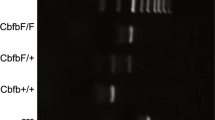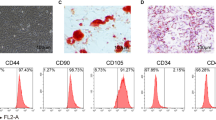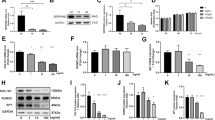Abstract
Nonunion is a challenging complication of fractures for the surgeon. Recently the Lys-Asp-Glu-Leu (KDEL) endoplasmic reticulum protein retention receptor 2 (KDELR2) has been found that involved in osteogenesis imperfecta. However, the exact mechanism is still unclear. In this study, we used lentivirus infection and mouse fracture model to investigate the role of KDELR2 in osteogenesis. Our results showed that KDELR2 knockdown inhibited the osteogenic differentiation of mBMSCs, whereas KDELR2 overexpression had the opposite effect. Furthermore, the levels of active-β-catenin and phospho-GSK3β (Ser9) were upregulated by KDELR2 overexpression and downregulated by KDELR2 knockdown. In the fracture model, mBMSCs overexpressing KDELR2 promoted healing. In conclusion, KDELR2 promotes the osteogenesis of mBMSCs by regulating the GSK3β/β-catenin signaling pathway.







Similar content being viewed by others
Availability of data and materials
The datasets used and/or analyzed during the current study are available from the corresponding author on reasonable request.
Abbreviations
- mBMSCs:
-
Mouse bone marrow mesenchymal stem cells
- ALP:
-
Alkaline phosphatase
- ARS:
-
Alizarin red staining
- shRNA:
-
Short hairpin RNA
- KDELR2:
-
KDEL (Lys-Asp-Glu-Leu) endoplasmic reticulum protein retention receptor 2
- GAPDH:
-
Glyceraldehyde-3-phosphate dehydrogenase
- COL1A1:
-
Collagen type I alpha 1 chain
- RUNX2:
-
Runt-related transcription factor 2
- GSK3β:
-
Glycogen synthase kinase 3 beta
References
Bajaj R, Kundu ST, Grzeskowiak CL et al (2020) IMPAD1 and KDELR2 drive invasion and metastasis by enhancing Golgi-mediated secretion. Oncogene 39:5979–5994. https://doi.org/10.1038/s41388-020-01410-z
Beaver R, Brinker MR, Barrack RL (1997) An analysis of the actual cost of tibial nonunions. J La State Med Soc Off Organ La State Med Soc 149(6):200–206
Beurel E, Grieco SF, Jope RS (2015) Glycogen synthase kinase-3 (GSK3): regulation, actions, and diseases. Pharmacol Ther 148:114–131. https://doi.org/10.1016/j.pharmthera.2014.11.016
Braga Frade B, da Cunha D, Muller L, Bonfim DC (2022) Establishing a Diaphyseal Femur Fracture Model in Mice. J vis Exp JoVE. https://doi.org/10.3791/64766
Bruder SP, Kurth AA, Shea M et al (1998) Bone regeneration by implantation of purified, culture-expanded human mesenchymal stem cells. J Orthop Res off Publ Orthop Res Soc 16:155–162. https://doi.org/10.1002/jor.1100160202
Capitani M, Sallese M (2009) The KDEL receptor: new functions for an old protein. FEBS Lett 583:3863–3871. https://doi.org/10.1016/j.febslet.2009.10.053
Clevers H, Nusse R (2012) Wnt/β-catenin signaling and disease. Cell 149:1192–1205. https://doi.org/10.1016/j.cell.2012.05.012
Day TF, Guo X, Garrett-Beal L, Yang Y (2005) Wnt/beta-catenin signaling in mesenchymal progenitors controls osteoblast and chondrocyte differentiation during vertebrate skeletogenesis. Dev Cell 8:739–750. https://doi.org/10.1016/j.devcel.2005.03.016
Ding VW, Chen RH, McCormick F (2000) Differential regulation of glycogen synthase kinase 3beta by insulin and Wnt signaling. J Biol Chem 275:32475–32481. https://doi.org/10.1074/jbc.M005342200
Embi N, Rylatt DB, Cohen P (1980) Glycogen synthase kinase-3 from rabbit skeletal muscle. Separation from cyclic-AMP-dependent protein kinase and phosphorylase kinase. Eur J Biochem 107:519–527
Freyberg Z, Ferrando SJ, Javitch JA (2010) Roles of the Akt/GSK-3 and Wnt signaling pathways in schizophrenia and antipsychotic drug action. Am J Psychiatry 167:388–396. https://doi.org/10.1176/appi.ajp.2009.08121873
Giganti MG, Tresoldi I, Masuelli L et al (2014) Fracture healing: from basic science to role of nutrition. Front Biosci Landmark Ed 19:1162–1175. https://doi.org/10.2741/4273
Glass GE, Chan JK, Freidin A et al (2011) TNF-alpha promotes fracture repair by augmenting the recruitment and differentiation of muscle-derived stromal cells. Proc Natl Acad Sci USA 108:1585–1590. https://doi.org/10.1073/pnas.1018501108
Gremse F, Stärk M, Ehling J et al (2016) Imalytics Preclinical: interactive Analysis of Biomedical Volume Data. Theranostics 6:328–341. https://doi.org/10.7150/thno.13624
Hak DJ, Fitzpatrick D, Bishop JA et al (2014) Delayed union and nonunions: epidemiology, clinical issues, and financial aspects. Injury 45(Suppl 2):S3-7. https://doi.org/10.1016/j.injury.2014.04.002
Hooper JE (2003) Smoothened translates Hedgehog levels into distinct responses. Dev Camb Engl 130:3951–3963. https://doi.org/10.1242/dev.00594
Hsu VW, Shah N, Klausner RD (1992) A brefeldin A-like phenotype is induced by the overexpression of a human ERD-2-like protein, ELP-1. Cell 69:625–635. https://doi.org/10.1016/0092-8674(92)90226-3
Huang S, Xu L, Zhang Y et al (2015) Systemic and local administration of allogeneic bone marrow-derived mesenchymal stem cells promotes fracture healing in rats. Cell Transplant 24:2643–2655. https://doi.org/10.3727/096368915X687219
Islam F, Chaousis S, Wahab R et al (2018) Protein interactions of FAM134B with EB1 and APC/beta-catenin in vitro in colon carcinoma. Mol Carcinog 57:1480–1491. https://doi.org/10.1002/mc.22871
Liao Z, She C, Ma L et al (2019) KDELR2 Promotes glioblastoma tumorigenesis targeted by HIF1a via mTOR signaling pathway. Cell Mol Neurobiol 39:1207–1215. https://doi.org/10.1007/s10571-019-00715-2
Liu W, Zhao Z, Na Y et al (2018) Dexamethasone-induced production of reactive oxygen species promotes apoptosis via endoplasmic reticulum stress and autophagy in MC3T3-E1 cells. Int J Mol Med 41:2028–2036. https://doi.org/10.3892/ijmm.2018.3412
Livingston TL, Gordon S, Archambault M et al (2003) Mesenchymal stem cells combined with biphasic calcium phosphate ceramics promote bone regeneration. J Mater Sci Mater Med 14:211–218. https://doi.org/10.1023/a:1022824505404
MacDonald BT, Tamai K, He X (2009) Wnt/beta-catenin signaling: components, mechanisms, and diseases. Dev Cell 17:9–26. https://doi.org/10.1016/j.devcel.2009.06.016
Mao H, Nian J, Wang Z et al (2020) KDELR2 is an unfavorable prognostic biomarker and regulates CCND1 to promote tumor progression in glioma. Pathol Res Pract 216(7):152996. https://doi.org/10.1016/j.prp.2020.152996
McCrea PD, Turck CW, Gumbiner B (1991) A homolog of the armadillo protein in Drosophila (plakoglobin) associated with E-cadherin. Science 254:1359–1361. https://doi.org/10.1126/science.1962194
Meng X, Li W, Yuan H et al (2022) KDELR2-KIF20A axis facilitates bladder cancer growth and metastasis by enhancing Golgi-mediated secretion. Biol Proced Online 24:12. https://doi.org/10.1186/s12575-022-00174-y
Mills CN, Nowsheen S, Bonner JA, Yang ES (2011) Emerging roles of glycogen synthase kinase 3 in the treatment of brain tumors. Front Mol Neurosci 4:47. https://doi.org/10.3389/fnmol.2011.00047
Minde DP, Radli M, Forneris F et al (2013) Large extent of disorder in Adenomatous Polyposis Coli offers a strategy to guard Wnt signalling against point mutations. PLoS ONE 8:e77257. https://doi.org/10.1371/journal.pone.0077257
Peng Y, Kang Q, Cheng H et al (2003) Transcriptional characterization of bone morphogenetic proteins (BMPs)-mediated osteogenic signaling. J Cell Biochem 90:1149–1165. https://doi.org/10.1002/jcb.10744
Pountos I, Georgouli T, Pneumaticos S, Giannoudis PV (2013) Fracture non-union: can biomarkers predict outcome? Injury 44:1725–1732. https://doi.org/10.1016/j.injury.2013.09.009
Qiao Z, Greven J, Horst K et al (2018) Fracture healing and the underexposed role of extracellular vesicle-based cross talk. Shock Augusta Ga 49:486–496. https://doi.org/10.1097/SHK.0000000000001002
Rao TP, Kühl M (2010) An updated overview on Wnt signaling pathways: a prelude for more. Circ Res 106:1798–1806. https://doi.org/10.1161/CIRCRESAHA.110.219840
Ryan G, Magony R, Gortler H et al (2021) Systemically impaired fracture healing in small animal research: a review of fracture repair models. J Orthop Res off Publ Orthop Res Soc 39:1359–1367. https://doi.org/10.1002/jor.25003
Semenza JC, Hardwick KG, Dean N, Pelham HR (1990) ERD2, a yeast gene required for the receptor-mediated retrieval of luminal ER proteins from the secretory pathway. Cell 61:1349–1357. https://doi.org/10.1016/0092-8674(90)90698-e
Shi M, Song W, Han T et al (2017) Role of the unfolded protein response in topography-induced osteogenic differentiation in rat bone marrow mesenchymal stem cells. Acta Biomater 54:175–185. https://doi.org/10.1016/j.actbio.2017.03.018
van Dijk FS, Semler O, Etich J et al (2020) Interaction between KDELR2 and HSP47 as a Key Determinant in Osteogenesis Imperfecta Caused by Bi-allelic Variants in KDELR2. Am J Hum Genet 107:989–999. https://doi.org/10.1016/j.ajhg.2020.09.009
Wei H, Ma W, Lu X et al (2021) KDELR2 promotes breast cancer proliferation via HDAC3-mediated cell cycle progression. Cancer Commun Lond Engl 41:904–920. https://doi.org/10.1002/cac2.12180
Zhang X, Zhou C, Zha X et al (2015) Apigenin promotes osteogenic differentiation of human mesenchymal stem cells through JNK and p38 MAPK pathways. Mol Cell Biochem 407:41–50. https://doi.org/10.1007/s11010-015-2452-9
Acknowledgements
We thank the clients who have offered assistance to this study from Clinical Research Center of the second affiliated hospital, Zhejiang university, including Xing Zhang, Meirong Yu, Sicong Chen, Liya Lin, Yunlu Chen, et al. We also appreciate the general help of Linlin Zhang and Shoumin Feng from Orthopedics Research Institute of Zhejiang University.
Funding
This work was supported by the National Natural Science Foundation of China (NO.82172189 and No. 81871759) and the Joint Funds of the Zhejiang Provincial Natural Science Foundation of China (No. LBY21H060004 and No.LY21H070001).
Author information
Authors and Affiliations
Contributions
Deting Xue and Zhijun Pan designed the research; Xiaoyong Wu, Weijun Zhang and Long Long performed the in vitro experiments; Xiaoyong Wu, Yibo Wang, Weijun Zhang, Kanbin Wang and Jinwu Bai performed the in vivo experiments; Xiaoyong Wu and Zhongxiang Wang analyzed the data; Xiaoyong Wu wrote the paper; Deting Xue and Zhijun Pan revised the paper. All authors have read and approved the manuscript.
Corresponding authors
Ethics declarations
Ethics approval
All animal experiments were in accordance to the Animal Care and Use Committee guidelines of Zhejiang University. All experimental procedures were in accordance with the and Institutional Animal Care Use Committee at the Second Affiliated Hospital, School of Medicine, Zhejiang University.
Consent to participate
Not applicable.
Consent for publication
Not applicable.
Competing interests
The authors declare no conflicts of interest.
Additional information
Publisher's Note
Springer Nature remains neutral with regard to jurisdictional claims in published maps and institutional affiliations.
Rights and permissions
Springer Nature or its licensor (e.g. a society or other partner) holds exclusive rights to this article under a publishing agreement with the author(s) or other rightsholder(s); author self-archiving of the accepted manuscript version of this article is solely governed by the terms of such publishing agreement and applicable law.
About this article
Cite this article
Wu, X., Zhang, W., Long, L. et al. KDELR2 promotes bone marrow mesenchymal stem cell osteogenic differentiation via GSK3β/β-catenin signaling pathway. Cell Tissue Res 396, 269–281 (2024). https://doi.org/10.1007/s00441-024-03884-9
Received:
Accepted:
Published:
Issue Date:
DOI: https://doi.org/10.1007/s00441-024-03884-9




